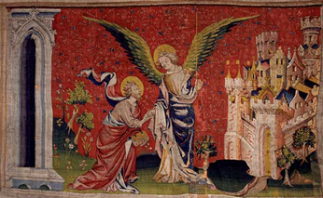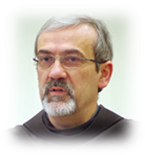SEPTEMBER 2016 κάνετε κλικ εδώ για το πρωτότυπο στα Ελληνικά
…but overcome evil with good (Rom. 12, 21)

It is important to know that what Saint Paul says above is not only possible, but it is indeed the best and more effective response to evil.
Injustice, calumny, violence…they all tend to add to unhappiness. All these things are not “autonomous”, i, e. they do not happen by themselves; behind them are some persons, who willfully or unwittingly cause these type of evil. Our first reaction might be the thought of returning evil for evil or revenge and similar actions. This course, however, maintains an endless cycle of retribution. And that is not all…This course will deprive one of his inner peace. Inner peace rests upon a guileless and well-intended heart; without this peace man becomes the plaything of his feelings and, unavoidably, sooner or later he will exteriorize his inner state in the environment around him. In what exactly does this inner peace consist? Our Faith provides the answer: it consists in our reconciliation with God, who is the source of our reconciliation with our own selves and with our fellow men and women. Just imagine for a moment, if Jesus HAD NOT forgiven his executors, HAD NOT forgiven Peter and HAD NOT accepted to be sacrificed on the cross for our sins, taking upon himself the sins of the entire humanity since the beginning of Creation, i.e. every act of violence, injustice, calumny, arrogance and so forth.
We would be living in a merciless world, a dark world without any ray of light and hope for something radically liberating.
The Lord, however, FORGAVE his executors, forgave Peter and encouraged his Disciples to, at all times, be eager to forgive “seventy times seven” those who have offended them.
What does this big number mean? It means that we shall always have to face multiple sins and offenses from all directions, for evil has entered the world. It also means that with Christ we have overcome sin and we are able to stop the vicious circle of violence.
We accomplish this under the sign of the Cross. The Church is always under the shadow of the Cross. This reality, though, at the same time guarantees the Resurrection that will follow, the Redemption, and the Salvation. We have already experienced God’s reign; his reign is present in every good thought and act, in every act of solidarity towards our fellow men, in every giving of ourselves for the good of others, be it our time, or money or encouragement or any other initiative that promotes the common good.
The universal reign of peace
In the last days the mountain of the Lord’s temple will be established as chief among the mountains; it will be raised above the hills, and all nations will stream to it.
Many peoples will come and say:
Come, let us go to the mountain of the Lord, to the house of the God of Jacob.
He will teach us his ways, so that we may walk in his paths. The law will go out from Zion, the word of the Lord from Jerusalem. He will judge between the nations and will settle disputes for many peoples.
They will beat their swords into ploughshares and their spears into pruning hooks. Nation will not take up sword against nation, nor will they train for war any more (Is, 2; 1-4)
The new Jerusalem

The Revelation of Saint John taking anew the prophetic texts of the Old Testament that describe the new Jerusalem —mainly from the books of Ezekiel and Isaiah– presents to us the image of the perfection of the Church, bride of Christ, (Rev. 21, 1 –22, 5), a radiant marvel and a heavenly city.
The texts are interpreted in such a manner that the earthly Jerusalem recedes in front of our eyes.
We look now for its heavenly model and prototype.
But, it is the Church on earth that reflects the heavenly model of Jerusalem, for She participates in her mystery: it is the holy city trampled upon by the idolaters through persecutions, but she is finally saved, purified and beautiful as a bride.
The promises given temporarily to that earthly Jerusalem pass on to another Jerusalem, the Church, modern and at the same time turned towards her ultimate perfection, mother of us all, heir of the divine promises and definitive homeland of the saved ones.
Above, “the Angel shows to John the heavenly Jerusalem”, from the famous tapestries of Angers, France, 14th century.
The tapestries of Revelation

In the French city of Angers, Louis 1st, duke of Angers, ordered the Flemish artist Jean Bondol to design scenes from the Revelation of Saint John, in order to have them woven into tapestries at Paris, in the workshop of Nicola Bataille.
The work took five years (1377– 1382) and the final result was ninety scenes from the Revelation, in six parts, each part measuring 24m by 6.1m, (see on the right), i.e. 144 meters by 6.1 in total!
Their colours are bright and vivid and the pictures wonderful, all inspired by the sacred book.
Louis placed them in the city’s cathedral.
However, during the French Revolution (1789) whatever had not been hidden away for safekeeping from the fury of the revolutionaries was destroyed.
Seventy-one scenes have avoided destruction and were found almost accidentally in 1848.
They are now kept and looked after at a permanent exhibition at Angers’ castle.
Did you know…
Jerusalem is mentioned in Akkadian finds of the 14th century BC as Urushalim (= instituted by the god Shalem).
Biblical tradition recognizes Jerusalem as the city of Melchisedek, temporary of Abraham (around 1900 BC).
David conquers it from the Jebusites in about 1010 BC, and his son Solomon, in 962 BC builds the Temple on the eastern side of the city.
From then on the religious significance of Jerusalem establishes its character as the holy city and gives to it a primary role as regards the faith and hope of Israel.
For the Christians, however, its role in the divine plan belongs to the past.
What remains now is its deep significance as it is revealed in the New Testament.
Indeed, if the history of Jesus finishes in Jerusalem with his sacrifice, his appearances and his ascension, from this city too it carries on and takes off the history of the witness of the Apostles.
It is there that they receive the Spirit, there they form the first Christian community and there they suffer the first persecutions. From there they begin to evangelize the whole world. Saint Paul will emphasize that the old Jerusalem has been taken over by the new Jerusalem that has its roots in heaven (Gal. 4, 27-31).
(From the “Dictionary of Biblical Theology”, Athens 1980)
f. Pierbattista Pizzaballa o.f.m.

We are in the heart of the Church and the world here, and the biggest challenge we are facing today is to not be constrained into enduring difficult situations, but to be actively and with a critical attitude interested in them.
This is what he said among other things, in an interview, the 51 years-old Franciscan f. Pierbattista Pizzaballa, who has been appointed by Pope Francis on 23 last June as the apostolic Administrator of the Latin Patriarchate of Jerusalem.
Coming from Bergamo in Italy, he studies theology at the Pontifical Antonian University. He is ordained priest in 1990.
He serves as assistant professor in Biblical Hebrew in Jerusalem and becomes Custos (Guardian) of the Holy Land from 1999 till 2011.
This current month he will be ordained bishop and he is expected to succeed H.B. Patriarch Fou’ad Tual, who has retired due to his age.
The Latin Patriarchate of Jerusalem, to which Cyprus belongs (along with Israel, Palestine and Jordan), numbers 293,000 faithful, 464 priests, 9 deacons and 1,612 religious.
Worthy and long live!
From the Holy Scriptures


By the rivers of Babylon we sat and wept when we remembered Zion.
There on the poplars we hung our harps, for there our captors asked us for songs,
our tormentors demanded songs of joy; they said,
“Sing us of the songs of Zion!”
How can we sing the songs of the Lord while in a foreign land?
If I forget you, O Jerusalem, may my right hand forget its skill.
May my tongue cling to the root of my mouth if I do not remember you,
if I do not consider you Jerusalem my highest joy.
(Psalm 137, 1-6)
Timeless radiance

At the time of Constantine the Great (272-337 AD) Jerusalem gets established as a place of pilgrimage for the Christian who ardently desire to see the places where the Son of God walked, taught, healed, was crucified and rose from the dead.
The discovery of the Holy Cross and of the Holy Sepulchre, of the grotto of Bethlehem and of Calvary, which happened at that time, they brought the land of Palestine into the limelight, so to speak.
It is, also, then that for the first time in history (in a letter of the Emperor Constantine) Palestine is referred to as “the Holy Land”.
During the reign of Constantine were built the church of the Resurrection (with the Holy Sepulchre at its centre), and that of the Birth of Christ in Bethlehem —today only parts of the floor of the original building remain, the church was rebuilt by Justinian in the 6th century— as well as a church at the Mount of Olives, honouring the Ascension of the Lord.
Innumerable pilgrims stream to the Holy Land from every corner of the planet, honouring the earthly coming of the Lord and seeking a deeper relationship with Him.
click here for Greek
Extremely interesting and well written! I look forward to reading more.
LikeLike
Thanks for your positive feedback
LikeLike